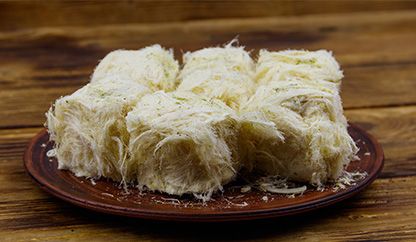
Helva held an essential place in the Ottoman palace, being prepared on significant occasions such as births in the harem, the accession of the heir prince to the throne, and victorious battles. Because helva was extensively consumed in the palace, there was an independent architectural structure called the "helvahane" in the kitchen section of the palace. The absence of other kitchen structures like soup kitchens, rice kitchens, or kebab kitchens highlights the significant role helva played in the palace kitchen.
Besides its service related to nutrition, the helvahane also served as the palace pharmacy. A published Helvahâne register includes 186 types of medicinal recipes, including pastes, syrups, and pills. Thus, it wouldn't be wrong to perceive the helvahane and the palace kitchens as institutions providing healthcare services.
In the Topkapı Palace, the sweet-making organization was called the "Helvahane Ocağı" (Halva Kitchen). Over time, it was given different names like Helvahane Matbah-ı Amire, Helvahane-i Hassa, Helvahane-i Amire, and Helvahane-i Manure. The building of the Helvahane was constructed by the architect Mimar Sinan during the reign of Suleiman the Magnificent. It was rebuilt and given its final form by Mimar Sinan again after a major fire that occurred in the palace kitchens during the reign of Sultan Selim II.
Those who worked in the Helvahane were referred to as "Helvacıyan-ı Hassa." The successful ones among them could become "Helvacıbaşı," "Caşnigirbaşı," or "Hoşafcıbaşı." The Helvacıbaşı was subordinate to the Kilercibaşı (chief steward) in the Enderun. Helvacılar were represented third in the palace protocol under the name of the Kilercibaşı. In the 16th century, it is understood from archive documents that there were 812 people working in the Helvahane, and their names and origins were listed one by one.
The helvas prepared in the palace were quite diverse. The first-class quality of the ingredients used in helva making, such as flour, starch, semolina, sesame, butter, milk, and sweeteners like honey, grape molasses, and sugar, was mandatory. The origins of the materials coming into the palace kitchen were predetermined for the various regions of the empire. Honey was brought from Crete, Wallachia, and Moldavia. A significant portion of the butter came from Kaffa, and sugar was imported from Egypt to make helva.